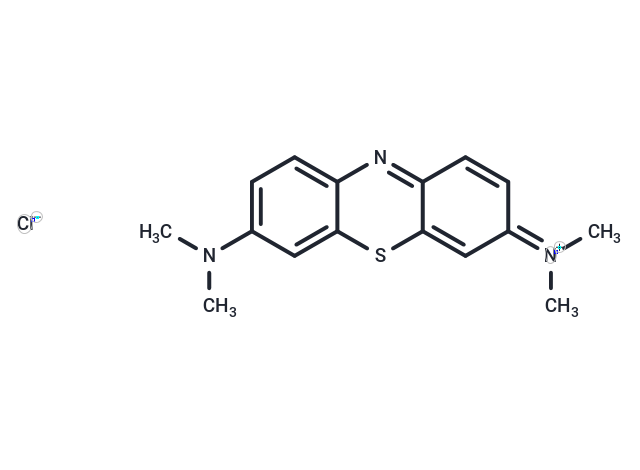Shopping Cart
- Remove All
 Your shopping cart is currently empty
Your shopping cart is currently empty

Methylene Blue (Tetramethylthionine chloride) (IC50 of 1.9 μM) inhibits tau filament formation. And it inhibits soluble guanylyl cyclase. It is also used as a dye in chromoendoscopy.

| Pack Size | Price | Availability | Quantity |
|---|---|---|---|
| 50 mg | $30 | In Stock | |
| 100 mg | $42 | In Stock | |
| 200 mg | $54 | In Stock | |
| 500 mg | $76 | In Stock |
| Description | Methylene Blue (Tetramethylthionine chloride) (IC50 of 1.9 μM) inhibits tau filament formation. And it inhibits soluble guanylyl cyclase. It is also used as a dye in chromoendoscopy. |
| Targets&IC50 | Tau aggregation:1.9 μM, GC: |
| In vitro | MB could inactivate nitric oxide directly by generating superoxide anions, it may inhibit the action of nitric oxide synthase itself. In addition to interfering with the nitric oxide–cyclic guanosine monophosphate pathway, there are MB directly activating calcium-dependent potassium channels and enhancing the release of noradrenaline from intracellular stores. |
| In vivo | Methylene Blue decreases C-GMP and vascular smooth muscle relaxation by inhibiting guanylate cyclase. Pharmacokinetic studies in rodents showed that MB injects by intravascular resulting in a rapid and extensive accumulation of this drug in the central nervous system (CNS). When MB is injected intravenously, it selectively gathers in parathyroid glands, therefore is easy for the identification of structures during surgery. |
| Kinase Assay | Isolated Integrin Binding Assays.:Purified integrin (1 μg/mL; 4℃) is used to coat 96-well microtitre plates, which are then blocked with bovine serum albumin (BSA) (3% in 1 mM CaCl2, 1 mM MgCl2,10 pM MnCl2, 100 mM NaC1,50 mM Tris-hydroxymethyl-aminomethane; pH 7.4), and incubated (3 h at 30 ℃) with biotinylated ligands (1 pg/mL in binding buffer: 0.1% BSA, 1 mM CaCl2,1 mM MgCl2, 10 μM MnCl2, 100 mM NaCl, 50 mM Tris-hydroxymethyl-aminomethane; pH 7.4) in the presence or absence of serially diluted peptides. After washing (3×5 min with binding buffer), the bound biotinylated ligand is detected with alkaline-phosphatase conjugated goat anti-biotin antibodies (1 μg/mL; 1 h, 37℃), using p-nitrophenyl phosphate as chromogen. Cyclo (-RGDfK) binding in the absence of competitor is defined as 100% signal; binding to blocked wells in the absence of integrin is defined as 0%. Concentrations of Cyclo (-RGDfK) required for 50% inhibition of signal (IC50 values) are estimated graphically. |
| Cell Research | Immature neuroblasts, isolated from the newborn rat subventricular zone, differentiate into γ-aminobutyric acid–mediated neurons are exposed at the sixth day in vitro to MB (10 μM) for 2h. Assess the survival and dendritic arbor architecture of these cells 48h after this treatment paradigm. |
| Animal Research | MB (5 or 50 mg/kg) diluted in normal saline were injected intraarterially into Sprague- Dawley male rats over the 30s. |
| Alias | Tetramethylthionine chloride, methylthioninium chloride, CI-52015, Basic Blue 9 |
| Molecular Weight | 319.85 |
| Formula | C16H18ClN3S |
| Cas No. | 61-73-4 |
| Smiles | [Cl-].CN(C)c1ccc2nc3cc\c(cc3sc2c1)=[N+](/C)C |
| Relative Density. | 1 |
| Storage | keep away from direct sunlight | Powder: -20°C for 3 years | In solvent: -80°C for 1 year | Shipping with blue ice. | |||||||||||||||||||||||||
| Solubility Information | H2O: 3.2 mg/mL (10 mM), Sonication is recommended. DMSO: 1 mg/mL (3.13 mM), Sonication is recommended. | |||||||||||||||||||||||||
Solution Preparation Table | ||||||||||||||||||||||||||
DMSO/H2O
H2O
| ||||||||||||||||||||||||||

Copyright © 2015-2025 TargetMol Chemicals Inc. All Rights Reserved.